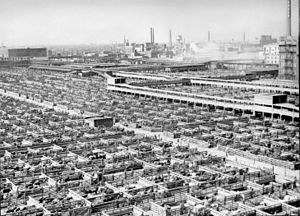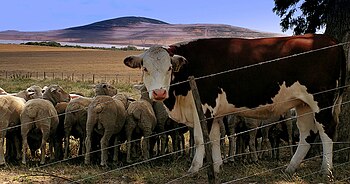Selasa, 25 Maret 2008
Senin, 24 Maret 2008
Husbandry
Livestock
From Wikipedia, the free encyclopedia
Livestock is the term used to refer (singularly or plurally) to a domesticated animal intentionally reared in an agricultural setting to make produce such as food or fibre, or for its labour. The term generally does not include poultry or farmed fish.
Livestock may be raised for subsistence or for profit. Raising animals (animal husbandry) is an important component of modern agriculture. It has been practiced in many societies, since the transition to farming from hunter-gather lifestyles.
Origins of livestock

Animal-rearing has its origins in the transition of societies to settled farming communities rather than hunter-gatherer lifestyles. Animals are ‘domesticated’ when their breeding and living conditions are controlled by humans. Over time, the collective behaviour, life cycle, and physiology of livestock have changed radically. Many modern farm animals are unsuited to life in the wild. Goats and sheep were domesticated around 8000 BCE in Asia.[citation needed] Swine or pigs were domesticated by 7000 BCE in the Middle East and China[1]. The earliest evidence of horse domestication dates to around 4000 BCE[citation needed]
Types of livestock
The term "livestock" is nebulous and may be defined narrowly or broadly.
On a broader view, livestock refers to any breed or population of animal kept by humans for a useful, commercial purpose. This can mean domestic animals, semi-domestic animals, or captive wild animals. Semi-domesticated refers to animals which are only lightly domesticated or of disputed status. These populations may also be in the process of domestication.
In practical discussions, some people may use the term livestock to refer just to domestic animals or even just to red meat animals.
‘Livestock’ are defined, in part, by their end purpose as the production of food or fiber, or labour.
The economic value of livestock includes:
- Meat
- the production of a useful form of dietary protein and energy.
- Dairy products
- Mammalian livestock can be used as a source of milk, which can in turn easily be processed into other dairy products such as yogurt, cheese, butter, ice cream, kefir, and kumis. Using livestock for this purpose can often yield several times the food energy of slaughtering the animal outright.
- Fiber
- Livestock produce a range of fiber/textiles. For example, sheep and goats produce wool and mohair; cows, deer, and sheep can make leather; and bones, hooves and horns of livestock can be used.
- Fertilizer
- Manure can be spread on fields to increase crop yields. This is an important reason why historically, plant and animal domestication have been intimately linked. Manure is also used to make plaster for walls and floors and can be used as a fuel for fires. The blood and bone of animals are also used as fertilizer.
- Labour
- Animals such as horses, donkey, and yaks can be used for mechanical energy. Prior to steam power livestock were the only available source of non-human labour. They are still used for this purpose in many places of the world, including ploughing fields, transporting goods, and military functions.
- Land management
- The grazing of livestock is sometimes used as a way to control weeds and undergrowth. For example, in areas prone to wild fires, goats and sheep are set to graze on dry scrub which removes combustible material and reduces the risk of fires.
During the history of animal husbandry many secondary products have arisen in an attempt to increase carcass utilization and reduce waste. For example, animal offal and non-edible parts may be transformed into products such as pet food and fertilizer. In the past such waste products were sometimes also fed to livestock as well. However, intra-species recycling poses a disease risk, threatening animal and even human health (see bovine spongiform encephalopathy (BSE), scrapie and prion). Due primarily to BSE (mad cow disease), feeding animal scraps to animals has been banned in many countries, at least in regards to ruminants.

